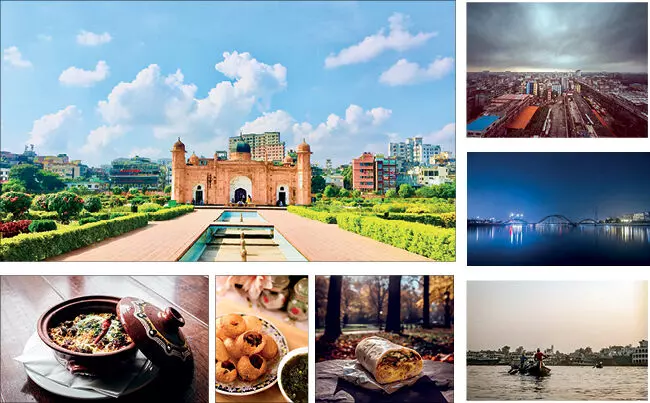Bridged by cultural kinship
Bordering the bustling Kolkata, Dhaka shares a common thread of vibrant Bengali culture with its Indian counterpart, characterised by profound simplicity and spirituality grounded in daily life; writes Monjit P.

As the morning sun cast its golden hues over the bustling city of Kolkata, I found myself standing at the Howrah Railway Station, anticipation coursing through my veins. My destination? The vibrant and culturally rich capital of Bangladesh, Dhaka. This journey promised not just a change in geography but also a shift in the tapestry of sights, sounds, and flavours that define this part of the world.
The train, adorned with colourful graffiti and the rhythmic clatter of steel wheels against tracks, served as my vessel for this adventure. The journey commenced with the train’s gentle sway, providing a poetic introduction to the odyssey that lay ahead. As we traversed the iconic Howrah Bridge, I couldn’t help but marvel at the confluence of history and modernity that this city embodies.
Leaving the clamour of Kolkata behind, the train whisked me through verdant landscapes dotted with quaint villages. The windows framed scenes of rural life—vivid green fields where farmers toiled, children playing cricket with unwavering enthusiasm, and women adorned in vibrant sarees fetching water from communal wells. The tableau was a testament to the simplicity and resilience that define the heartland.
As we approached the border between India and Bangladesh, a tangible change unfolded. The landscape transformed, mirroring the syncretic essence of these two nations sharing a border. The bustling markets and villages showcased the harmonious coexistence of Bengali cultures, with the air resonating with the sounds of Rabindra Sangeet and the aroma of delectable street food wafting through the open windows.
The border crossing was an experience in itself. Stepping onto foreign soil, I was greeted by the vibrant hues of Bangladesh. The immigration process, with its bureaucratic intricacies, was a reminder of the geopolitical nuances that shape our travels. However, the friendly smiles of the officials and the shared excitement among fellow travellers transcended bureaucratic formalities, creating an atmosphere of camaraderie.
Dhaka, with its kaleidoscope of colours and chaotic charm, welcomed me with open arms. The streets, teeming with rickshaws, street vendors, and a cacophony of voices, felt like a living, breathing entity. The first stop on my Dhaka itinerary was the historic Ahsan Manzil, a palace that resonates with the tales of Nawabs and colonial influences. The architectural grandeur and the museum within its walls offered a glimpse into the opulent past of this dynamic city.
Wandering through the narrow lanes of Old Dhaka, I found myself immersed in the hustle and bustle of Shankhari Bazar. The aroma of spices hung in the air as shopkeepers peddled their wares, and the intricate designs of local handloom fabrics caught my eye. The Lalbagh Fort, a majestic structure with its imposing walls and serene surroundings, was a testament to the city’s rich Mughal heritage.
My culinary exploration of Dhaka was a journey of flavours. From the irresistible street food like fuchka and kathi rolls to the aromatic biryanis served in traditional clay pots, each dish narrated a story of centuries-old culinary traditions. Dining at a local eatery, surrounded by the vivacity of Dhaka’s residents, I couldn’t help but savour the authenticity that each bite offered—a culinary voyage that mirrored the city’s diversity.
The Lalbagh Shahi Mosque, with its intricate architecture and serene courtyard, provided a moment of respite amidst the urban chaos. As the call to prayer echoed through its hallowed halls, I marvelled at the seamless blend of spirituality and daily life in this city.
No visit to Dhaka would be complete without a boat ride on the Buriganga River. The traditional wooden boats, adorned with colourful flags, ferried us through the heart of the city. The riverbanks bustled with activity—laundry being washed, children playing, and vendors selling their wares. The boat ride offered a unique perspective of Dhaka, a city in constant motion yet rooted in its traditions.
Venturing into the intellectual hub of Dhaka, I explored the vibrant campus of the University of Dhaka. The Shaheed Minar, a memorial dedicated to the language martyrs, stood tall, a poignant reminder of the sacrifices made for linguistic identity. The energy of the students, the fervour for knowledge, and the artistic expressions that adorned the walls painted a picture of a city that thrives on its intellectual heritage.
As I bid farewell to Dhaka, the memories of this journey lingered like the notes of a beautiful melody. The train journey back to Kolkata was filled with reflections on the cultural odyssey I had undertaken. Crossing the border once again, I carried with me not just the stamps on my passport but a treasure trove of experiences that transcended boundaries.
In the quiet moments between the rhythmic clatter of the train, I marvelled at the invisible threads that connect Kolkata and Dhaka. Beyond the geopolitical demarcations, these two cities share a common heritage, a shared history that permeates through their streets, markets, and cultural expressions.
As the train pulled into Howrah Station, I stepped onto familiar ground with a heart enriched by the cultural symphony that resonates between Kolkata and Dhaka. This journey was not just a physical traverse of borders; it was a soulful exploration of the shared narratives that bind these two cities, making them an inseparable part of the same cultural tapestry.
The writer is a freelance travel journalist.




